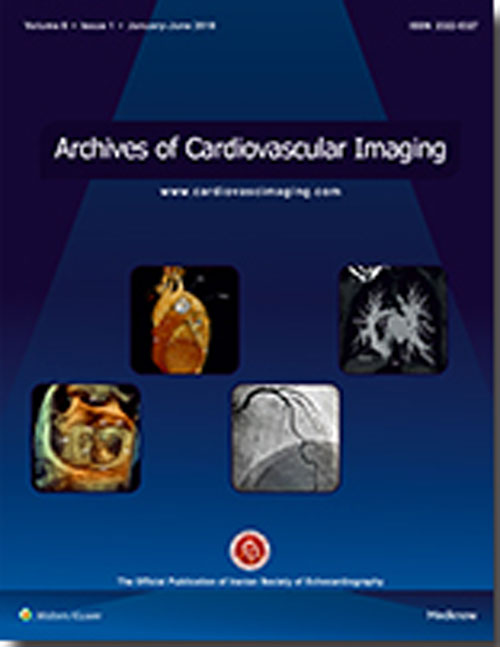فهرست مطالب
Archives Of Cardiovascular Imaging
Volume:2 Issue: 2, May 2014
- تاریخ انتشار: 1392/04/05
- تعداد عناوین: 11
-
Page 1Transcatheteraortic valve implantation, first introduced in 2002, has been established as an alternative modality for patients deemed not suitable for open-heart surgery. The anatomical vicinity of the atrioventricular node and the His bundle to the non-coronary and rightcoronary aortic cusps predisposes patients to conduction abnormalities in case of severe calcification or mechanical trauma during valve implantation. However, the two evaluated valves (CoreValve and Edwards SAPIEN valve) have different rates of these complications, mainly driven by their respective geometry..Currently, there is ongoing evaluation of the true rate of conduction disorders and their clinical relevance or durability. The initial experience of fatal outcomes with conduction disorders such as complete atrioventricular block has increased the rate of subsequent pacemaker implantation up to 50%. However, prophylactic pacemaker implantation is associated with several possible complications. Thus, there is a need for further data from large-scale series taking into account the true rate of clinically relevant conduction disorders..Keywords: Heart Valve Prosthesis Implantation, Atrioventricular Block, Bundle, Branch Block, Pacemaker, Artificial, Bundle of His
-
Page 2BackgroundEvaluation of the accuracy and performance of sonography units needs tissue-mimicking phantoms. These phantoms play an important role by simulating soft tissues, obviating the need to experiment on humans or animals..ObjectivesTo present a simple sonographic phantom for quality control and training purposes..Materials And MethodsThe presented phantom consists of a two-part Plexiglas box. The larger part is filled with a mixture of ethanol (9.5 ± 0.25%) in distilled water and a solution of sodium nitrite (0.1 M) to prevent rusting. The second part is filled with a combination of 3.85% by wt. % agar, and 50 g/L of powdered graphite as the background material. In this study, chrome-plated electric guitar strings, 0.52 mm in diameter, were used. Several objects were considered as tissue-equivalent material, and their images were obtained at different times. Criteria for the selection of suitable objects comprised similarity between the obtained image and the corresponding tissues in the human body, minimal shrinkage, and change in brightness level at different times. In addition to quantitative analysis obtained from image processing, a blind qualitative study was done by a radiologist..ResultsBoth results of quantitative analysis using MATLAB software and independent qualitative analysis showed that the commercial rubber and agar were appropriate as solid and cystic objects, respectively. Moreover, quantitative analysis done with MATLAB on images obtained from the phantom showed that the commercial rubber and agar had a 5% and 2% change in image pixel intensity (brightness) after 2 months, respectively..ConclusionsThe presented phantom not only has lower cost and complexity, which make it suitable for educational centers, but also is capable of providing good images of cystic and solid objects for quality control and training purposes. Furthermore, it confers reliable stability for at least 2 months, as was assessed in the present study..Keywords: Sonography, Quality Control, Training, Phantom
-
Page 3BackgroundPatients with severe refractory cardiac angina who are not candidates for any form of invasive treatment and are already on optimal medical therapy have few therapeutic options. Enhanced external counter pulsation (EECP) offers an alternative palliative and possibly therapeutic option for these patients. EECP achieves this by inducing hemodynamic effects much similar to those of the intra-aortic balloon pump..ObjectivesWe sought to further evaluate these therapeutic effects, especially on the basis of echocardiographic data..Patients andMethodsThirty-two patients who had severe refractory angina despite full anti-ischemic medication and were poor candidates for invasive procedures were evaluated. After undergoing 35 sessions of EECP, the patients were followed up for 6 months for adverse events, change in quality of life, severity of the remaining symptoms according to the Canadian Cardiovascular Society (CCS) classification, and echocardiographic changes..ResultsAfter receiving standard EECP treatment regimen, the patients showed a marked increase in quality of life scores; a significant decrease in left ventricular (LV) end-diastolic volume index after 6 months (P = 0.045), in tandem with an increase in the LV myocardial performance index (P = 0.04) with no significant change in the LV ejection fraction; and a significant decrease in the CCS scores (P = 0.01). In addition, physical performance measures, including time to unset of angina during the exercise test, were significantly increased..ConclusionsEECP is a useful and low-risk additive therapeutic option in patients with end-stage and non-responsive angina symptoms who are receiving optimal medical conventional treatments and are not good candidates for invasive procedures. This treatment can induce some positive remodeling in the LV..Keywords: Enhanced external counter pulsation (EECP), Positive Remodeling, Severe Refractory Angina, Myocardial Performance Index (MPI), Echocardiography
-
Page 4BackgroundThe conus artery is usually the first branch of the right coronary artery (RCA) and passes around the right ventricular outflow tract..ObjectivesTo examine whether it is possible to visualize the conus artery in multi-slice computed tomography (CT)..Patients andMethodsIn 79 consecutive patients (aged 56 ± 12.9 years; 13 women), 64-slice CT was performed due to a suspicion of coronary artery disease. The standard protocol for scanning with retrospective gating was used for all the patients..ResultsIt was possible to visualize the conus artery in coronary CT angiography in 64 (81%) patients. The course of the conus artery in the right ventricle was commonly in the outflow tract direction. The conus artery was visualized at a distance of 33.2 ± 16.3 mm. The average diameter of the conus artery was 2.3 ± 0.8 mm. The conus artery most frequently originated from the first segment of the right coronary artery (53%) and directly from the aorta (37.9%). In the rest of the cases, there was a common trunk for both vessels (CA/RCA)..ConclusionsIn most cases, the conus artery can be visualized in cardiac CT. A description of the conus artery should be a part of the standard clinical coronary CT angiography description..Keywords: Arteries, Tomography, Spiral Computed, Angiography, Coronary Vessels


